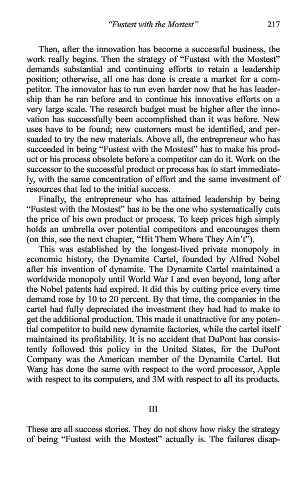Page 224 - ENTREPRENEURSHIP Innovation and entrepreneurship
P. 224
53231_Innovation and Entrepreneurship.qxd 11/8/2002 10:50 AM Page 217
“Fustest with the Mostest” 217
Then, after the innovation has become a successful business, the
work really begins. Then the strategy of “Fustest with the Mostest”
demands substantial and continuing efforts to retain a leadership
position; otherwise, all one has done is create a market for a com-
petitor. The innovator has to run even harder now that he has leader-
ship than he ran before and to continue his innovative efforts on a
very large scale. The research budget must be higher after the inno-
vation has successfully been accomplished than it was before. New
uses have to be found; new customers must be identified, and per-
suaded to try the new materials. Above all, the entrepreneur who has
succeeded in being “Fustest with the Mostest” has to make his prod-
uct or his process obsolete before a competitor can do it. Work on the
successor to the successful product or process has to start immediate-
ly, with the same concentration of effort and the same investment of
resources that led to the initial success.
Finally, the entrepreneur who has attained leadership by being
“Fustest with the Mostest” has to be the one who systematically cuts
the price of his own product or process. To keep prices high simply
holds an umbrella over potential competitors and encourages them
(on this, see the next chapter, “Hit Them Where They Ain’t”).
This was established by the longest-lived private monopoly in
economic history, the Dynamite Cartel, founded by Alfred Nobel
after his invention of dynamite. The Dynamite Cartel maintained a
worldwide monopoly until World War I and even beyond, long after
the Nobel patents had expired. It did this by cutting price every time
demand rose by 10 to 20 percent. By that time, the companies in the
cartel had fully depreciated the investment they had had to make to
get the additional production. This made it unattractive for any poten-
tial competitor to build new dynamite factories, while the cartel itself
maintained its profitability. It is no accident that DuPont has consis-
tently followed this policy in the United States, for the DuPont
Company was the American member of the Dynamite Cartel. But
Wang has done the same with respect to the word processor, Apple
with respect to its computers, and 3M with respect to all its products.
III
These are all success stories. They do not show how risky the strategy
of being “Fustest with the Mostest” actually is. The failures disap-

